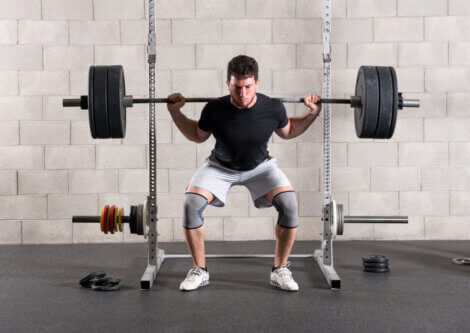Why Is It Important to Include your Legs in your Workout?

Many people tend to form their fitness training plan around the upper body. They focus on their pecs, arms, and back with the goal of getting that sculpted look. There are even those who consider that it’s not important (or at least less important) to include their legs in the workout.
Now, what about you? Have you ever wondered why it’s important to include specific exercises for your legs in your workout? Well, one thing to keep in mind is that you should work your whole body to avoid becoming unbalanced, both at a physiological and a muscular level. Let’s take a look at several reasons why it’s important to exercise your legs.
Three reasons to include your legs in your workout
Looking good is generally the first objective that someone wants to reach when they start training. It’s impossible to deny it or argue that they’re just doing it for their health, although this secondary goal increases in importance over time. For that reason, the majority of exercise routines focus especially on working out your arms and chest.
Of course, some athletes set aside one day a week to work on their legs. However, the loads and intensity level often aren’t sufficient to balance out the rest of the body’s workout. Despite that, the person may feel they’re already exercising their legs enough and leave it at that.
Over time, these unbalanced exercise routines can cause injuries or pain. This doesn’t just mean in the legs, but could also involve the lower or middle back, due to muscular imbalance.
1. Body imbalance
Your legs have muscle groups of considerable size, which carry out specific motor skill jobs. These are activities such as walking, jogging, running, and bending, among others. You can perform tasks like these thanks to your lower body, a part of your body that you should exercise frequently.

Therefore, if you often forget to include specific exercises for your legs, you’ll notice an imbalance in your body sooner or later. The way this problem often shows up is in the form of muscular atrophy, which can gradually make the above tasks more and more difficult.
2. Physiological problems
Imbalance doesn’t just happen on a physical level. With regards to your physiological side, your body will start to perceive different problems due to a lack of training. In this respect, you’ll realize it’s important to include your legs in your workouts for your health, well apart from the aesthetic side.
Most leg exercises involve strengthening the muscles. Since the leg muscle groups are so large, this work directly influences your body’s production of testosterone. If you don’t work on your legs, the hormone’s production can be greatly affected.
3. Working on your core
The middle section of your body, known as the core, is one of the most important areas of the body, thanks to the various jobs involving balance and support that it does every day. That’s why the muscle groups in your core should always be active and strong.
Despite that, you can’t just strengthen your core with crunches and back exercises. It’s also crucial to exercise your legs regularly since the constant movement of the lower body will also strengthen many of your core muscle groups.
Why don’t as many people include legs in their workout?
Apart from a lack of knowledge or a purely appearance-based focus, there are also other reasons why many don’t consider leg exercises an important part of their workout. Many argue that the time they have for exercise is very limited, and therefore they focus their time only on other areas, such as their arms.
Others consider that their legs are already well developed and that they look fine as it is. However, this brings you back to the same idea: the goal of exercising is more than just looking good; it’s something that you should do for your health.

Lastly, another group of people are sincere and admit that the idea of leg exercises doesn’t appeal to them. This is closely linked to motivation since everyone puts more effort and enthusiasm into exercises they enjoy more. However, other exercises are important too.
Keep learning about including your legs in your workout
Don’t let a lack of knowledge or a negative attitude influence you in an important aspect of your fitness such as exercising your legs. It’s a good idea to ask for advice from a professional.
A fitness professional can help you design a training plan that suits your needs, and that includes all of the different areas of your body. A good trainer can also help you with motivation when you feel you don’t have the necessary energy.
If you have the opportunity to use the services of a personal trainer, you’ll definitely be able to make the most of your workout time. That way, you’ll have access to better motivation and supervision, and you’ll get better results.
Many people tend to form their fitness training plan around the upper body. They focus on their pecs, arms, and back with the goal of getting that sculpted look. There are even those who consider that it’s not important (or at least less important) to include their legs in the workout.
Now, what about you? Have you ever wondered why it’s important to include specific exercises for your legs in your workout? Well, one thing to keep in mind is that you should work your whole body to avoid becoming unbalanced, both at a physiological and a muscular level. Let’s take a look at several reasons why it’s important to exercise your legs.
Three reasons to include your legs in your workout
Looking good is generally the first objective that someone wants to reach when they start training. It’s impossible to deny it or argue that they’re just doing it for their health, although this secondary goal increases in importance over time. For that reason, the majority of exercise routines focus especially on working out your arms and chest.
Of course, some athletes set aside one day a week to work on their legs. However, the loads and intensity level often aren’t sufficient to balance out the rest of the body’s workout. Despite that, the person may feel they’re already exercising their legs enough and leave it at that.
Over time, these unbalanced exercise routines can cause injuries or pain. This doesn’t just mean in the legs, but could also involve the lower or middle back, due to muscular imbalance.
1. Body imbalance
Your legs have muscle groups of considerable size, which carry out specific motor skill jobs. These are activities such as walking, jogging, running, and bending, among others. You can perform tasks like these thanks to your lower body, a part of your body that you should exercise frequently.

Therefore, if you often forget to include specific exercises for your legs, you’ll notice an imbalance in your body sooner or later. The way this problem often shows up is in the form of muscular atrophy, which can gradually make the above tasks more and more difficult.
2. Physiological problems
Imbalance doesn’t just happen on a physical level. With regards to your physiological side, your body will start to perceive different problems due to a lack of training. In this respect, you’ll realize it’s important to include your legs in your workouts for your health, well apart from the aesthetic side.
Most leg exercises involve strengthening the muscles. Since the leg muscle groups are so large, this work directly influences your body’s production of testosterone. If you don’t work on your legs, the hormone’s production can be greatly affected.
3. Working on your core
The middle section of your body, known as the core, is one of the most important areas of the body, thanks to the various jobs involving balance and support that it does every day. That’s why the muscle groups in your core should always be active and strong.
Despite that, you can’t just strengthen your core with crunches and back exercises. It’s also crucial to exercise your legs regularly since the constant movement of the lower body will also strengthen many of your core muscle groups.
Why don’t as many people include legs in their workout?
Apart from a lack of knowledge or a purely appearance-based focus, there are also other reasons why many don’t consider leg exercises an important part of their workout. Many argue that the time they have for exercise is very limited, and therefore they focus their time only on other areas, such as their arms.
Others consider that their legs are already well developed and that they look fine as it is. However, this brings you back to the same idea: the goal of exercising is more than just looking good; it’s something that you should do for your health.

Lastly, another group of people are sincere and admit that the idea of leg exercises doesn’t appeal to them. This is closely linked to motivation since everyone puts more effort and enthusiasm into exercises they enjoy more. However, other exercises are important too.
Keep learning about including your legs in your workout
Don’t let a lack of knowledge or a negative attitude influence you in an important aspect of your fitness such as exercising your legs. It’s a good idea to ask for advice from a professional.
A fitness professional can help you design a training plan that suits your needs, and that includes all of the different areas of your body. A good trainer can also help you with motivation when you feel you don’t have the necessary energy.
If you have the opportunity to use the services of a personal trainer, you’ll definitely be able to make the most of your workout time. That way, you’ll have access to better motivation and supervision, and you’ll get better results.
All cited sources were thoroughly reviewed by our team to ensure their quality, reliability, currency, and validity. The bibliography of this article was considered reliable and of academic or scientific accuracy.
- Vargas, D. B., Cabrera, O. R., Arancibia, F. H., Angélica Elorrieta, M. G., Olave, C. C., & Torres, R. T. (2011). IV. Entrenamiento muscular de las extremidades inferiores en el paciente con enfermedad pulmonar obstructiva crónica CONSENSO CHILENO DE REHABILITACIÓN RESPIRATORIA EN EL PACIENTE CON EPOC. In Rev Chil Enf Respir.
- Frank H. Netter, M. (2015). Netter – Atlas de Anatomía Humana. In Masson. https://doi.org/10.1017/CBO9781107415324.004
- Heredia, J.R.; Chulvi, I; Ramón, M. (2006). CORE: Entrenamiento de la zona media. EFdeportes.ComISSN.
This text is provided for informational purposes only and does not replace consultation with a professional. If in doubt, consult your specialist.








